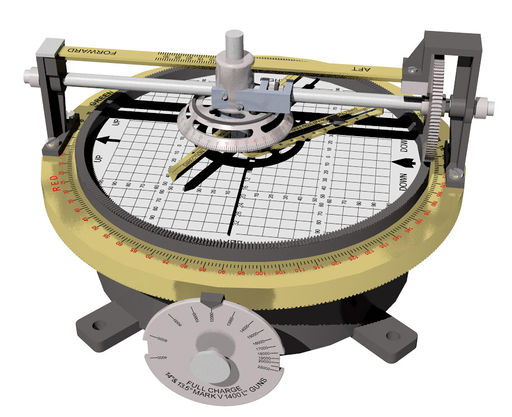Wind Dumaresq
A Wind Dumaresq is a type of dumaresq specially appointed to help factor out the influence of wind on a fire control problem. It was adapted from the Mark IV dumaresq after an initial project called the "Vernon Dumaresq Attachment" was fashioned to demonstrate the idea[1].

The knob by which gun range was entered. This knob spun the cylindrical member bearing numeric indications of the correction to deflection to be applied. The prominent label as to which gun system this pertains to strongly suggests that the cylinders were common to all types and that the knobs that spun them were the parts machined in a manner that reflected the ballistic properties of the gun system at hand. Furthermore, the type of powder charge being mentioned suggests that the knob could be pulled out and replaced by another for (say) Half Charge firings. The British were clever like that, and used similar swap-outs in their Range Master Transmitters.
Function
The wind dumaresq calculated the amount of lateral deflection the wind's influence would exert on the shell as it flew downrange, allowing a correction to be applied. It did not calculate the influence of the wind along the line of bearing; that function was performed by the Dreyer Calculator usually mounted on the bulkhead of the T.S.. The wind dumaresq used enemy bearings in relative form (unlike the Mark VI), but lacked a bearing clock, and so the operator had to spend a little more time maintaining the bearing (which he could do by observing the Dreyer table's main dumaresq).
The wind dumaresq's dial plate was fixed and the outer brass ring revolves about it. Unlike the Mark VI, however the scale for own speed on this device extends toward "Forward", and not "Aft". This is because, unlike a regular Dumaresq, where we want to subtract our own ship's motion from that of the enemy ship, here we want to subtract the wind induced by our own ships motion from the "wind you feel", and the first quantity is the opposite of our ship's motion vector.
Overall, it was a fairly high maintenance busy-box, as he was also required to enter the present gun range, own speed, and the "wind you feel".
The face of the wind dumaresq had a knob by which the operator would input the present gun range (which he could obtain by checking the gun range counter on the Dreyer Table). As he spun this range knob, a cylinder under the dial plate (extending laterally from red 90 to green 90 in the renderings above) would spin, with numbers written on it to indicate the number of knots of deflection that would be needed as a correction. The number to use would be that in line with the enemy bar pipper. It would naturally be the placement of the numbers on the drum under the dial plate that recorded the subtle relationship of how far the shell would be displaced as it traveled downrange. When you consider this, you'll grasp that the amount of this displacement will be a function of the time of flight (which is what the gun range dial is truly expressing, as time of flight is, in turn, a function of gun range) and the component of the "wind you feel" which crosses the line of sight.
Service History
The wind dumaresqs were first manufactured in early 1917, and were incorporated into Dreyer tables such as the Mark III and Mark V as improvements[2]. In other ships, the instrument was probably situated elsewhere in the TS, as it did not really integrate with the Dreyer tables, per se.
The wind dumaresq apparently saw service through World War II, as examples can still be found within the transmitting stations of H.M.C.S. Haida[3] and H.M.S. Belfast.
Footnotes
- ↑ Schleihauf, Bill. The Dumaresq and the Dreyer Part I. p.8.
- ↑ Handbook for Capt. FC Dreyer's Fire Control Tables, Plates 10 & 40.
- ↑ Schleihauf, Bill. The Dumaresq and the Dreyer Part I. p.8.
Bibliography
